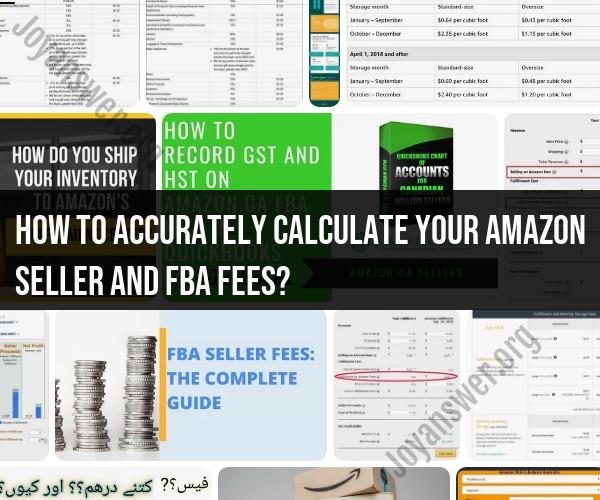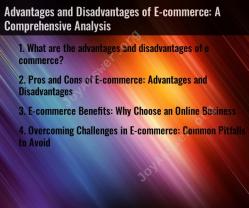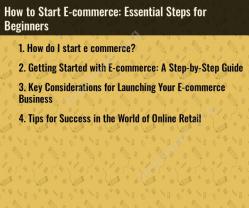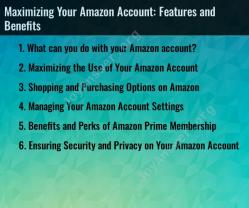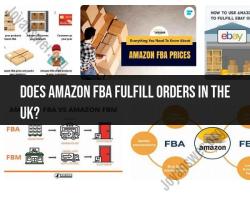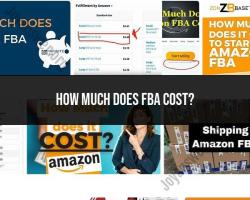How to accurately calculate your Amazon Seller and FBA fees?
Accurately calculating your Amazon Seller and Fulfilled by Amazon (FBA) fees is crucial for understanding your costs and profitability as an Amazon seller. These fees can vary based on factors such as the type of product you're selling, its size, and your Amazon seller account type. Here are essential tips to help you calculate your Amazon Seller and FBA fees accurately:
1. Understand the Types of Fees:
Referral Fees: These are fees that Amazon charges based on the category of your product. Each category has a different referral fee percentage, which is a percentage of the item's sale price.
Fulfillment Fees (FBA Fees): If you use Amazon FBA, you'll pay fulfillment fees based on the size and weight of your products. These fees cover the costs of storage, packing, and shipping.
Storage Fees: For FBA sellers, storage fees are charged based on the amount of space your inventory occupies in Amazon's fulfillment centers. These fees are assessed on a monthly basis and vary depending on the time of year.
2. Determine Your Product Category:
Each product on Amazon belongs to a specific category, and each category has a different referral fee percentage. To accurately calculate referral fees, make sure you know the correct category for your product.
3. Measure Product Size and Weight:
For FBA fees, it's important to accurately measure the size and weight of your products. Amazon uses these measurements to determine fulfillment fees, so use a reliable scale and measuring tools. If your measurements are incorrect, it could lead to higher fees or product removal.
4. Use Amazon's Fee Calculator:
Amazon provides a Fee Calculator tool that allows you to estimate your fees for a specific product listing. This tool takes into account the product category, selling price, shipping cost, and other variables to provide an accurate fee estimate.
5. Review Amazon's Fee Schedule:
Amazon provides a Fee Schedule that details the referral fees for each product category and the fulfillment fees for FBA. Consult this schedule to understand the fees that apply to your products.
6. Factor in Additional Costs:
Don't forget to account for other costs associated with your Amazon business, such as shipping costs to Amazon's fulfillment centers, Amazon subscription fees (if applicable), and promotional costs (e.g., advertising on Amazon).
7. Monitor Seasonal and Storage Fees:
Storage fees for FBA can vary throughout the year, with higher fees during peak seasons. Keep an eye on your inventory levels and consider removing or reducing the amount of slow-moving inventory to minimize storage fees.
8. Use Accounting Software:
Consider using accounting software specifically designed for Amazon sellers, such as QuickBooks or Xero. These tools can help you keep track of your income, expenses, and fees, providing a comprehensive view of your financials.
9. Periodically Review Your Pricing Strategy:
Regularly review your product prices to ensure they cover both your costs and the associated Amazon fees while remaining competitive in the marketplace.
10. Seek Professional Guidance:
If you have a complex Amazon business with multiple products, varying fees, and international sales, it may be beneficial to consult with an accountant or financial professional who specializes in e-commerce businesses. They can provide valuable guidance on fee calculation, tax implications, and overall financial management.
Accurately calculating your Amazon Seller and FBA fees is crucial for making informed business decisions and ensuring your profitability on the platform. By following these tips and utilizing Amazon's tools, you can better manage your costs and run a successful Amazon selling business.
Accurately Calculating Your Amazon Seller and FBA Fees
Accurately calculating your Amazon seller and FBA fees is essential for ensuring profitability. There are a number of factors to consider when calculating your fees, including:
Referral fees: Referral fees are a percentage of the total sale price of your product. The referral fee varies depending on the product category.
Closing fees: Closing fees are a fixed fee per item sold. The closing fee is $1.80 for most items.
FBA fulfillment fees: FBA fulfillment fees are based on the size and weight of your product. You can use the Amazon FBA fee calculator to estimate your fulfillment fees.
Other fees: There are a number of other fees that may apply, such as storage fees, long-term storage fees, and removal fees.
Step-by-Step Guide to Calculating Amazon FBA Costs
To calculate your Amazon FBA costs, follow these steps:
- Determine the referral fee for your product category.
- Determine the closing fee for your product.
- Estimate your FBA fulfillment fees using the Amazon FBA fee calculator.
- Identify any other fees that may apply.
- Add up all of the fees to determine your total Amazon FBA costs.
Tools and Resources for Fee Estimation
In addition to the Amazon FBA fee calculator, there are a number of other tools and resources available to help you estimate your Amazon seller and FBA fees. These include:
Amazon Seller Central Fee Calculator: The Amazon Seller Central Fee Calculator allows you to estimate your fees based on your product category, selling price, and shipping weight.
Third-party fee calculators: There are a number of third-party fee calculators available online. These calculators can provide you with a more detailed estimate of your fees.
Tips for Cost Management in Amazon FBA
There are a number of things you can do to manage your Amazon FBA costs:
- Choose the right fulfillment option: Amazon offers a number of fulfillment options, including FBA, Fulfillment by Merchant (FBM), and Seller Fulfilled Prime (SFP). The best fulfillment option for you will depend on your individual needs and circumstances.
- Optimize your product listings: By optimizing your product listings, you can increase your sales and reduce your referral fees.
- Bundle products: Bundling products can help you reduce your fulfillment fees.
- Use Amazon's shipping services: Amazon offers a number of shipping services that can help you reduce your shipping costs.
- Negotiate with Amazon: If you are a high-volume seller, you may be able to negotiate with Amazon to reduce your fees.
Common Fee Calculation Mistakes and How to Avoid Them
Some common fee calculation mistakes include:
- Not including all applicable fees: Be sure to include all applicable fees in your calculations, such as referral fees, closing fees, fulfillment fees, and storage fees.
- Using outdated fee information: Amazon's fees are subject to change. Be sure to use the most up-to-date fee information when calculating your fees.
- Not accounting for weight and dimensions: FBA fulfillment fees are based on the size and weight of your product. Be sure to accurately measure and weigh your products before calculating your fees.
- Not considering shipping costs: Shipping costs can add up quickly. Be sure to factor in shipping costs when calculating your total Amazon FBA costs.
By avoiding these mistakes, you can ensure that you are accurately calculating your Amazon seller and FBA fees.
